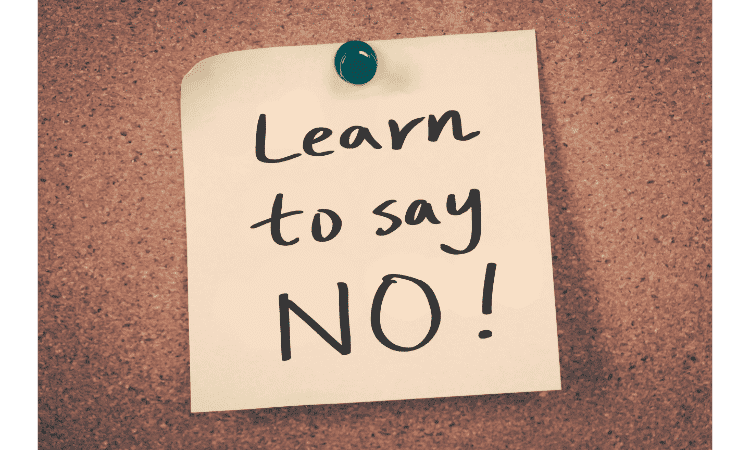
Are you constantly bending over backward to please others, even at the expense of your own well-being? Do you struggle to say “no” when someone asks for a favor, for fear of being perceived as rude or unkind? If so, you may be caught in the cycle of people-pleasing. People-pleasing is a common behavior that can stem from a variety of underlying issues, such as a fear of rejection, a desire for approval, or low self-esteem. It can be a difficult habit to break, but learning to set healthy boundaries and say “no” without guilt is crucial for maintaining your own well-being and happiness. In this blog post, we will explore the reasons behind people-pleasing behavior, and provide practical tips for breaking the cycle and learning to say “no” without regret.
What is People-pleasing

People-pleasing is a compulsive behavior where an individual feels the need to constantly put others’ needs before their own, even if it causes them stress or discomfort. This behavior is often driven by underlying issues such as low self-esteem, fear of rejection, or a need for validation and acceptance. People-pleasers may feel compelled to always say “yes” to social invitations or requests, or may neglect their own needs and wants in order to make others happy. People-pleasing can have negative consequences on an individual’s mental and physical well-being, and can also lead to the development of unhealthy relationships. It’s a learned behavior and it can be unlearned with self-awareness, assertiveness, and the ability to set boundaries.
Recognize the difference

One of the first steps to breaking the cycle of people-pleasing is to be able to distinguish between being helpful and being a people-pleaser. Being helpful means going out of your way to assist someone when you are able and want to. It’s an act of kindness and generosity. On the other hand, people-pleasing is a compulsive behavior where you feel the need to constantly put others’ needs before your own, even if it causes you stress or discomfort. It’s not an act of generosity but an act of seeking validation and acceptance.
It’s important to note that people-pleasing can manifest in different ways. It can be as simple as always saying “yes” to social invitations even if you would prefer to stay home, or as extreme as neglecting your own needs and wants in order to make others happy. The key is to identify when your actions are driven by a genuine desire to help and when they are driven by a need for validation or acceptance. This self-awareness will help you make conscious choices about how to interact with others, rather than falling into the pattern of people-pleasing.
Understand the reasons

To break the cycle of people-pleasing by saying no, it is important to understand the underlying reasons for this behavior. People-pleasing often stems from deeper psychological issues such as low self-esteem, fear of rejection, or a need for validation and acceptance if you say no.
For example, if you have low self-esteem, you may feel the need to constantly please others in order to gain their approval and validation. You may believe that if you can make others happy, they will like you and view you more positively.
Similarly, if you have a fear of rejection, you may constantly put others’ needs before your own in order to avoid any potential conflicts or disagreements. You may believe that if you always agree with others and do what they want, they will never reject you.
It’s also important to understand that people-pleasing can be a learned behavior, often developed during childhood. For example, if you were raised in an environment where your needs were not validated or were consistently ignored, you may have learned to put others’ needs before your own in order to get your needs met.
Understanding the reasons behind your people-pleasing behavior is the first step in being able to change it. By identifying the underlying issues, you can begin to address them and make different choices in your interactions with others.
Learn to set boundaries

Setting boundaries is an important part of breaking the cycle of people-pleasing. It means understanding and communicating your own needs and wants, and being able to say “no” when necessary. It’s important to remember that setting boundaries are not about being selfish or rude, it’s about taking care of yourself and protecting your own well-being.
When setting boundaries, it’s important to be clear and assertive in your communication. This means using “I” statements, such as “I need” or “I want” rather than “you should” or “you need to.” It also means being specific about what you are and is not willing to do. For example, instead of saying “I can’t help you”, say “I am not able to help you with that, but I can suggest someone else who can”
It’s also important to be flexible in your boundaries. It’s okay to change your mind and adjust your boundaries as needed. Being able to set and adjust boundaries is a skill that takes practice, but with time and effort, you will be able to communicate your needs and wants more effectively.
It’s also important to remember that setting boundaries don’t mean you have to cut off relationships with people who don’t respect your boundaries, it’s about finding a balance and mutual understanding and respect.
Practice saying “no” in small, low-stakes situations to build confidence.

Saying “no” can be difficult, especially if you’re used to constantly pleasing others. To build your confidence in setting boundaries and saying “no,” it can be helpful to start with small, low-stakes situations.
For example, you could practice saying “no” to non-essential invitations or requests, such as going out for drinks after work when you’re tired or taking on extra tasks at work that are not part of your job responsibilities. By starting with small and less significant requests, you’ll be able to build your confidence and develop a better sense of what you are and are not willing to do.
It’s also important to remember that saying “no” doesn’t have to be a big dramatic thing. You can simply and politely decline the request and move on. You don’t have to give an elaborate explanation or apologize for your decision.
Another way to practice saying “no” is to role-play the situation with a friend or family member. This can help you come up with different ways to decline requests and practice assertive communication in a low-pressure setting.
Practicing saying “no” in small situations will help you become more comfortable with the idea of setting boundaries and will make it easier to do it in more significant situations.
Saying “no” is a healthy and necessary part of any relationship.

Many people-pleasers view saying “no” as a negative thing, associating it with being rude, unkind, or unhelpful. However, this is not the case. Saying “no” is a healthy and necessary part of any relationship. It’s a way to communicate your needs and wants and to set boundaries.
It’s important to reframe the way you think about saying “no.” Instead of viewing it as something negative, understand that it is an important tool for maintaining your own well-being and for fostering healthy relationships. Saying “no” allows you to take care of yourself and to be honest about what you are and are not able or willing to do.
It’s also important to remember that saying “no” doesn’t mean the end of a relationship. It’s perfectly normal for people to have different needs and wants, and it’s important to respect and honor those differences. Saying “no” to someone’s request doesn’t mean that you don’t care about them or that you don’t want to be friends. It simply means that in that specific situation, you are unable or unwilling to do what they are asking.
Saying “no” is a key component of healthy relationships because it allows for mutual respect and understanding of boundaries. It allows people to be true to themselves and to each other. It’s important to understand that saying “no” is not a rejection but an act of self-care and respect.
Learn to separate your own needs and wants from those of others.

One of the key elements of breaking the cycle of people-pleasing is learning to separate your own needs and wants from those of others. People-pleasers often have difficulty distinguishing between what they truly want and what they think others want from them.
To begin separating your needs and wants from those of others, it’s important to start paying attention to your own thoughts and feelings. Take some time to reflect on what you truly want and need in different situations. This process can be helped by journaling or talking to a therapist.
Once you have a better understanding of your own needs and wants, it will be easier to distinguish them from those of others. It’s also important to remember that it’s okay to want and need different things than others. Everyone’s needs and wants are different, and it’s important to honor and respect those differences.
It’s also important to remember that it’s okay to prioritize your own needs and wants. It’s not selfish to put yourself first, it’s necessary for your own well-being. It’s important to understand that you are responsible for your own happiness and well-being and that it’s not always possible or necessary to put others’ needs before your own.
By learning to separate your needs and wants from those of others, you’ll be able to make decisions that align with your own values and priorities, rather than constantly trying to please others.
Prioritize your own well-being and happiness

People-pleasers often feel guilty for saying “no” or putting their own needs first. They may believe that they are being selfish or unkind by not constantly putting others’ needs before their own. However, this is not the case. Prioritizing your own well-being and happiness is not only necessary, but it’s also important for maintaining healthy relationships.
It’s important to remember that you are not responsible for the happiness or well-being of others. You can only control your own actions and decisions. By putting your own needs first, you are setting a positive example for others to follow, and showing them how to take care of themselves.
It’s also important to remember that saying “no” does not make you a bad person. Saying “no” is a healthy and necessary part of any relationship. It allows you to communicate your needs and wants, and to set boundaries. Saying “no” is not a rejection, but an act of self-care and respect.
Conclusion
In conclusion, breaking the cycle of people-pleasing is not easy, but it’s possible. It requires self-awareness, assertiveness, and the ability to set boundaries. Remember that it’s okay to prioritize your own well-being and happiness and that saying “no” does not make you a bad person. It takes time and practice, but with patience and perseverance, you’ll be able to break the cycle and live a happier, more fulfilling life.











